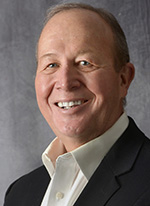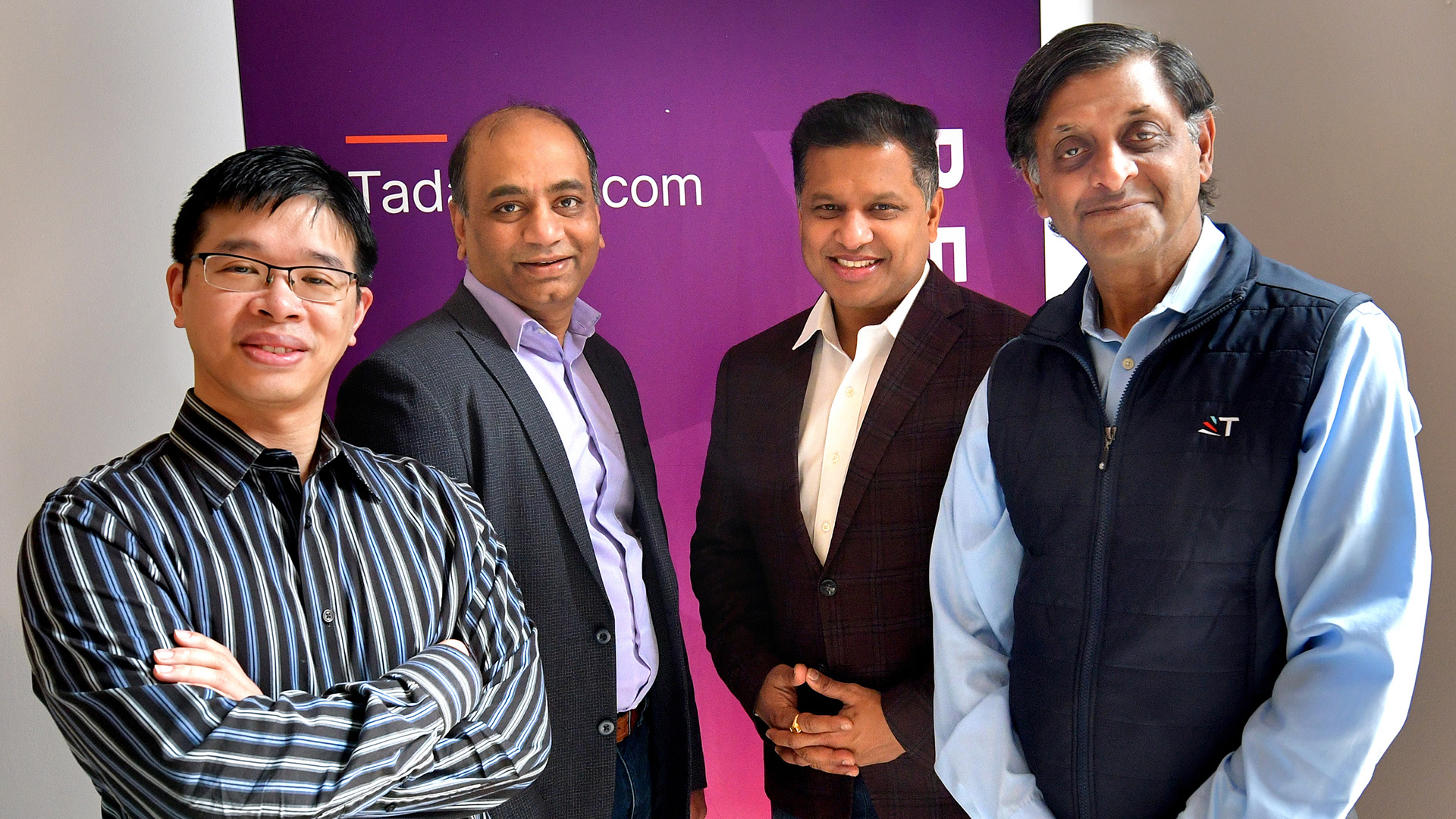Seshadri Guha and his team are transforming industrial supply chains, and taking on global warming too
For Seshadri Guha, the inspiration for his current company came out of his consulting work on a battlefield 7,000 miles away, some 15 years ago.
As chairman and managing partner of CGN Global at the time, he and his team were helping U.S. military commanders in Afghanistan make urgent, informed decisions in real time through integration technologies that allowed them to “see the entire battlefield,” providing them with the kind of top-to-bottom situational awareness necessary to successfully execute their missions.
Guha remembers thinking, “Is there a way to come up with a technology that can do the same thing for a company?”
It would take a few more years but out of that experience, Guha’s Peoria-based TADA Cognitive Solutions was born, in 2016. Today, TADA is engaged on another battlefront: helping large, industrial supply chains work better — faster, more efficiently, with less waste — for about 50 companies, with more to come as the firm forecasts explosive growth, all from a central Illinois base.
Along the way, Guha discovered a pleasantly surprising side benefit: a way for companies to reduce their carbon footprint toward the protection and preservation of a warming planet responding with sometimes devastating climate change.
‘The magic formula’
“Companies are by definition complex because they have so much to take care of,” Guha, 59, says from the labyrinthine office complex housing his TADA and CGN Global businesses in the 400 block along Adams and Washington streets in Downtown Peoria.
To deal with that complexity, businesses divided themselves into small, more manageable parts — essentially silos, he said. That created another problem, as these silos largely functioned independently, each “working in their own little world,” with limited knowledge or understanding of what the others were doing. The result was “chaos and confusion.” And waste, lots of it — of time, money and unwanted product.
Meanwhile, just throwing the newest, shiniest gadgets at companies didn’t mean much if they didn’t have the ability to assimilate that technology into their overall operations and get those gadgets talking to one another.
Guha, the self-described “engineer geek,” relished the challenge. He found his inspiration in nature, which starts with a building block: DNA. “In nine months, it grows into this little person that’s amazing,” able to learn, understand, evolve and respond to the world, Guha explained.
So, if companies also have a distinct DNA, what if you could isolate it in a kind of reverse-engineering process and create a “digital twin,” from which you could visualize the entire playing field and experiment with potential solutions? What if you could apply Artificial Intelligence (AI) technologies to assemble and digest vast amounts of data, and essentially connect the company’s left brain — the ability to grasp that information and make in-the-moment decisions from it — with its right brain and its predictive capabilities? And what if you could take a process that once took 24-36 months and reduce that down to 12-24 weeks?
That, in a nutshell, is what TADA — an anagram for the word “data” — helps companies do.
“It’s not just about collecting data. It’s about understanding the world we live in,” said Guha.
“That is the magic formula.”
A real-world example
All of this can be hard to get your brain around, so to simplify, let’s say you need a lawnmower.
For that tool to be available when you walk into your local home improvement store, its manufacturer must first coordinate with perhaps 300 different companies and the 800 different parts they make, all of which have to be assembled into that one piece of equipment, said Guha.
“The average supply chain is a 500-player game” between manufacturing, assembly, distribution, transportation, etc. “This thing has to come together, layer after layer.”
Now, throw in multiple, unforeseen shocks to companies and their supply chains: A global pandemic, supplier shutdowns, computer chip shortages, runaway inflation, war in Ukraine, etc. Pile all that on top of companies with too much stuff already, or not enough, or stuff that isn’t where it needs to be, with little idea of what’s still coming in or when.
“It’s like hitting (a fragile object) with a hammer,” said Guha. “It just goes everywhere.”
Enter TADA, whose timing could hardly have been better.
A digital replica of the company is created, a techno-landscape through which TADA can peer into the past, move more confidently into the future, empower employees and help the client “solve problems before they happen” in an ever-changing environment. While not every conceivable stressor can be anticipated, companies can learn the resilience necessary to survive the earthquakes.
At the end of the day, that company is “giving the customer what they want, when they want it,” with that lawnmower on the shelf at a Lowe’s or Home Depot when they arrive.
A planetary payoff
So, internal inefficiency and isolation are obviously wasteful. And when you think about the carbon emitted on the front end for those ordered parts that a business ends up not using, or for goods that customers ultimately don’t want, with their final destination being a landfill, well, fixing that would seem like a slam dunk.
Syamala Srinivasan, TADA’s chief analytics officer and director of its Center for Enterprise AI, certainly thinks so. While many companies are trying to address this or that aspect of the supply chain, “we’re looking at the entire supply chain,” she said. “How do I take the fat out?”
“If we can reduce the waste, we can reduce the carbon footprint,” added Guha. “We have to take care of 7 billion people at the end of the day … We also have to take care of the planet.”
Yet it’s not solely out of environmental altruism that companies should act, he said.
“I’d much rather it’s the right thing to do for the company. It’s the right thing to do for the customer. It’s also the right thing for the planet,” he said. Getting to that win-win-win, “that’s my passion.”
Growing, committed to doing it in Peoria
“We are past the point where we think we are inventing TADA,” said Guha. “We’re off the runway … going up to cruise altitude,” with “dramatic growth” projected over the next two to three years in sales and employment.
Today, TADA employs about 100 people, about half of them in Peoria. Guha can envision quadrupling that number, but believes it’s just as important “to see us have an outsized impact” beyond the vital stats.
Meanwhile, he’s dedicated to the Peoria that has become his home. Guha left his native India for the U.S. to get his master’s degree at Iowa State University, then moved to Peoria in 1988 to do contract engineering work at Caterpillar on behalf of Automated Analysis Corp. In 1995, he and two partners ventured out on their own with CGN, a business transformation consulting firm. Fast-forward 21 years to the birth of TADA, which now brags a growing list of clients including Navistar, Toro, Oshkosh and Harley-Davidson.
TADA’s efficiency-enhancing platform has helped employees “go home at 5 p.m. and 6 p.m. rather than working … 14 hours a day,” said Sajid Kunnummal, vice president and chief procurement officer at Navistar. “After a lot of assessment with multiple players, we found the right partner with TADA.”
Guha sees his intelligent data management platform having value not only in manufacturing but in health care and elsewhere.
“Guha likes to push the envelope and explore the world of possibilities,” said Jim Mormann, CEO of Integrated Solutions at OSF HealthCare. “Guha and his team are using intelligent analytics through the digital twin platform to help … determine what makes a number of our business services … work better and more efficiently. In some areas, such as facility management and health care technology management, this data can help OSF look at its spend rate years into the future, which ultimately will help us control costs.
“Aside from his excellent business acumen, Guha is passionate about the Peoria community as a whole and doing things right to see it prosper.”
As with any entrepreneurial effort, TADA needs to raise capital and recruit talent, and a partnership with Bradley University is helping with the latter. Peoria has been good to Guha — Caterpillar was his first customer — and he continues to be bullish on its promise.
“We are the smallest, biggest metropolis,” he said. “We have an unusual advantage. Everybody knows each other. There’s a lot of trust. … We are the perfect melting pot for creating new ideas.”
What central Illinois sometimes lacks is self-confidence. Guha invokes a former MIT professor of his, the notable systems scientist and author Peter Senge, who visited Peoria several years ago and listened to the local conversation. He recalls Senge saying afterwards something to the effect that “you keep worrying about what the whole world is going to do to Peoria,” a kind of victim mentality. “You have the ability to change the world.”
Which is what Guha is trying to do, from Peoria.
Companies come and companies go, but sometimes the locals need to ask themselves what attracted those companies here in the first place, what lured him. Guha does get asked, “Why not move to San Jose?”
“I need to do something that can help the industrial Midwest,” he responds. “This is as good a place as any.
“If TADA could be the Warren Buffett for Peoria” — the “Omaha for some of this industrial technology” with an innovation ecosystem craved by other creative companies — “I would love it.”





